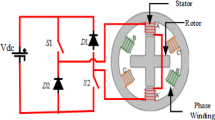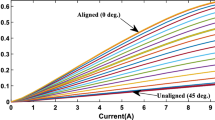Abstract
Switched Reluctance Motor (SRM) drives have gained a lot of attention in the drive domain because of their built-in benefits, which include ease of use, longevity, and compatibility with high-speed applications. Precise speed control is essential to minimize torque variations and maximize SRM performance. Traditionally, the proportional–integral controller is used for speed control. The nonlinearity and uncertain complexities of SRM have shifted the focus to sophisticated control techniques from conventional. In this work, the Model Predictive Controller (MPC) is applied for SRM speed control, and its performance is compared with that of conventional control methods. MPC improves speed control precision and disturbance rejection by taking into account input restrictions and system dynamics through optimization across a constrained prediction horizon, a strong fault tolerance capability. Furthermore, three different models are developed to control the speed of the SRM using a PI controller, a lookup table-based controller, and an adaptive neuro-fuzzy inference system controller to compare the results of MPC. Through extensive simulations, the study seeks to show how successful MPC is in terms of speed tracking accuracy, transient responsiveness, and stability when compared to standard control techniques, especially under variable operating circumstances and load disturbances. The practicality of the suggested control approach is illustrated by comparing it with other conventional control methods, and its performances are evaluated by using real-time simulator OPAL-RT 4510 under various situations.


















Similar content being viewed by others
Abbreviations
- AHB:
-
Asymmetric half-bridge
- ANFIS:
-
Adaptive neuro-fuzzy inference system
- EMF:
-
Electro-motive forces
- EV:
-
Electric vehicle
- IM:
-
Induction motor
- LUT:
-
Lookup table
- MPC:
-
Model predictive control
- PI:
-
Proportional integral
- PMSM:
-
Permanent magnet synchronous motor
- PWM:
-
Pulse width modulation
- SRM:
-
Switched reluctance motor
- \(\lambda\) :
-
Flux linkage
- \(T\) :
-
Electro-magnetic torque
- \(L\) :
-
Inductance
- \(i\) :
-
Stator phase current
- \(\theta\) :
-
Rotor position
- \(\theta_{ON}\) :
-
Turn-on angle
- \(\theta_{OFF}\) :
-
Turn-off angle
- \(\omega /\omega_r\) :
-
Rated rotor speed
- \(\omega_m\) :
-
Measured rotor speed
- \(\omega_e\) :
-
Rotor speed error
- \(i_{ref}\) :
-
Reference current signal
- \(T_r\) :
-
Torque ripple
- \(T_l\) :
-
Load torque
- \(T_s\) :
-
Settling time
References
Abhijith V, Hossain MJ, Lei G, Sreelekha PA, Monichan TP, Rao SV (2022) Hybrid switched reluctance motors for electric vehicle applications with high torque capability without permanent magnet. Energies (Basel) 15(21):7931. https://doi.org/10.3390/en15217931
Krishnan R (2001) ‘Switched reluctance motor drives: modeling, simulation, analysis, design, and applications’, [Online]. Available: www.TechnicalBooksPdf.com
Xiao D, Filho SR, Fang G, Ye J, Emadi A (2022) Position-sensorless control of switched reluctance motor drives: a review. IEEE Trans Transp Electrif 8(1):1209–1227. https://doi.org/10.1109/TTE.2021.3110867
Fahimi’ B, Suresh G, Ehsanil M ‘Review of sensorless control methods in switched reluctance motor drives’.
Valencia DF, Tarvirdilu-Asl R, Garcia C, Rodriguez J, Emadi A (2021) ‘A Review of predictive control techniques for switched reluctance machine drives. Part I: fundamentals and current control.’ IEEE Trans Energy Conv 36(2):1313. https://doi.org/10.1109/TEC.2021.3047983
Valencia DF, Tarvirdilu-Asl R, Garcia C, Rodriguez J, Emadi A (2021) ‘A Review of predictive control techniques for switched reluctance machine drives. Part II: Torque control, assessment and challenges. IEEE Trans Energy Conv 36(2):1323. https://doi.org/10.1109/TEC.2021.3047981
Mossa MA, El Ouanjli N, Gam O, Do TD (2023) Enhancing the performance of a renewable energy system using a novel predictive control method. Electronics (Switzerland). https://doi.org/10.3390/electronics12163408
Mohammed EM et al (2022) ‘Predictive torque and direct torque controls for doubly fed induction motor: A comparative study’, In: Lecture Notes in Networks and Systems, Springer Science and Business Media Deutschland GmbH, pp. 825–835. doi: https://doi.org/10.1007/978-3-031-01942-5_82.
Azizi S, Asemani MH, Vafamand N, Mobayen S, Fekih A (2022) Adaptive neural network linear parameter-varying control of shipboard direct current microgrids. IEEE Access 10:75825–75834. https://doi.org/10.1109/ACCESS.2022.3191385
Snyder S, Zhao P, Hovakimyan N (2021) Adaptive control for linear parameter-varying systems with application to a VTOL aircraft. Aerosp Sci Technol. https://doi.org/10.1016/j.ast.2021.106621
Ouddah N, Boukhnifer M, Chaibet A, Monmasson E (2014) Robust controller designs of switched reluctance motor for electrical vehicle, In: 22nd Mediterranean conference on control and automation (MED), Palermo, Italy.
Ouddah N, Loukkas N, Boukhnifer M, Chaibet A, Monmasson E (2015) Experimental evaluation of second sliding modes observer and Extended Kalman Filter in a sensorless robust control of Switched Reluctance Motor for EV application, In: 23rd IEEE Mediterranean conference on control and automation (MED), Torremolinos, Spain.
Wu W, Xie W, Li L (2020) Switching linear parameter-varying controller design with h∞performance based on youla parameterization. IEEE Access 8:184765–184773. https://doi.org/10.1109/ACCESS.2020.3029589
Fang G, Pinarello Scalcon F, Xiao D, Vieira R, Grundling H, Emadi A (2021) Advanced control of switched reluctance motors (SRMs): a review on current regulation, torque control and vibration suppression. IEEE Open J Ind Electron Soc 2:280–301. https://doi.org/10.1109/OJIES.2021.3076807
Egyetem Ó (2019) Zero energy buildings first italian network, IEEE Hungary Section, IEEE industrial electronics society, and institute of electrical and electronics engineers, IEEE CANDO-EPE 2019. In: IEEE 2nd international conference and workshop in Óbuda on electrical and power engineering proceedings: Budapest, Hungary
Al-Amyal F, Számel L, Hamouda M (2023) An enhanced direct instantaneous torque control of switched reluctance motor drives using ant colony optimization. Ain Shams Eng J 14(5):101967. https://doi.org/10.1016/j.asej.2022.101967
Manjula A, Kalaivani L, Gengaraj M, Maheswari RV, Vimal S, Kadry S (2021) Performance enhancement of SRM using smart bacterial foraging optimization algorithm based speed and current PID controllers. Comput Elect Eng. https://doi.org/10.1016/j.compeleceng.2021.107398
Gaafar MA, Abdelmaksoud A, Orabi M, Chen H, Dardeer M (2023) Switched reluctance motor converters for electric vehicles applications: comparative review. IEEE Trans Transp Electrif 9(3):3526–3544. https://doi.org/10.1109/TTE.2022.3192429
Gan C, Wu J, Sun Q, Kong W, Li H, Hu Y (2018) A review on machine topologies and control techniques for low-noise switched reluctance motors in electric vehicle applications. IEEE Access Inst Elect Electron Eng Inc 6:31430–31443. https://doi.org/10.1109/ACCESS.2018.2837111
Kawa M, Kiyota K, Furqani J, Chiba A (2019) Acoustic noise reduction of a high-efficiency switched reluctance motor for hybrid electric vehicles with novel current waveform. IEEE Trans Ind Appl 55:2519–2528. https://doi.org/10.1109/TIA.2018.2888847
Zhang M, Bahri I, Mininger X, Vlad C, Xie H, Berthelot E (2019) A new control method for vibration and noise suppression in switched reluctance machines. Energies (Basel) 12(8):1554. https://doi.org/10.3390/en12081554
Touati Z, Pereira M, Araújo RE, Khedher A (2022) Integration of switched reluctance generator in a wind energy conversion system: An overview of the state of the art and challenges. Energies 15(13):4743. https://doi.org/10.3390/en15134743
Mishra AK, Singh B (2021) Grid-integrated SRM-driven solar water pump with power flow management. IEEE J Emerg Sel Top Power Electron 9(3):2723–2734. https://doi.org/10.1109/JESTPE.2020.3022835
Khalil A, Husain I (2007) A fourier series generalized geometry-based analytical model of switched reluctance machines. IEEE Trans Ind Appl 43(3):673–684. https://doi.org/10.1109/TIA.2007.895737
Husain I, Hossain SA (2005) Modeling, simulation, and control of switched reluctance motor drives. IEEE Trans Industr Electron 52(6):1625–1634. https://doi.org/10.1109/TIE.2005.858710
Zhang P, Cassani PA, Williamson SS (2010) An accurate inductance profile measurement technique for switched reluctance machines. IEEE Trans Industr Electron 57(9):2972–2979. https://doi.org/10.1109/TIE.2010.2048831
Vujičić VP (2008) Modeling of a switched reluctance machine based on the invertible torque function. IEEE Trans Magn 44(9):2186–2194. https://doi.org/10.1109/TMAG.2008.2000663
Oscar De Araujo L, Henriques P, Branco PJC, Guilherme L, Rolim B, Suemitsu WI (2002) Proposition of an offline learning current modulation for torque-ripple reduction in switched reluctance motors: design and experimental evaluation.
Zeng H, Chen H, Shi J (2015) Direct instantaneous torque control with wide operating range for switched reluctance motors. IET Electr Power Appl 9(9):578–585. https://doi.org/10.1049/iet-epa.2015.0087
Loria A, Espinosa-Perez G, Chumacero E (2014) Exponential stabilization of switched-reluctance motors via speed-sensorless feedback. IEEE Trans Control Syst Technol 22(3):1224–1232. https://doi.org/10.1109/TCST.2013.2271446
Oshaba AS, Ali ES, Abd Elazim SM (2015) ACO based speed control of SRM fed by photovoltaic system. Int J Electr Power Energy Syst 67:529–536. https://doi.org/10.1016/j.ijepes.2014.12.009
Oshaba AS, Ali ES, Abd Elazim SM (2017) PI controller design for MPPT of photovoltaic system supplying SRM via BAT search algorithm. Neural Comput Appl 28(4):651–667. https://doi.org/10.1007/s00521-015-2091-9
Wang J (2018) Speed-assigned position tracking control of SRM with adaptive backstepping control. IEEE/CAA J Autom Sinica 5(6):1128–1135. https://doi.org/10.1109/JAS.2016.7510019
Ding W, Li J, Yuan J (2022) An improved model predictive torque control for switched reluctance motors with candidate voltage vectors optimization. IEEE Trans Industr Electron. https://doi.org/10.1109/TIE.2022.3190895
Wang T, Qiu J, Gao H, Wang C (2017) Network-based fuzzy control for nonlinear industrial processes with predictive compensation strategy. IEEE Trans Syst Man Cybern Syst 47(8):2137–2147. https://doi.org/10.1109/TSMC.2016.2616904
Wang T, Qiu J, Yin S, Gao H, Fan J, Chai T (2016) Performance-based adaptive fuzzy tracking control for networked industrial processes. IEEE Trans Cybern 46(8):1760–1770. https://doi.org/10.1109/TCYB.2016.2551039
Rafiq M, Rehman SU, Rehman FU, Butt QR, Awan I (2012) A second order sliding mode control design of a switched reluctance motor using super twisting algorithm. Simul Model Practice Theory 25:106–117. https://doi.org/10.1016/j.simpat.2012.03.001
Lukic SM, Emadi A (2010) State-switching control technique for switched reluctance motor drives: Theory and implementation. IEEE Trans Industr Electron 57(9):2932–2938. https://doi.org/10.1109/TIE.2009.2038942
Wang JJ (2016) A common sharing method for current and flux-linkage control of switched reluctance motor. Electric Power Syst Res 131:19–30. https://doi.org/10.1016/j.epsr.2015.09.015
Wang JJ (2016) Position tracking control of switched reluctance motor with adaptive linear element based on current-sharing method. Neurocomputing 190:209–216. https://doi.org/10.1016/j.neucom.2016.01.016
Kotb H, Yakout AH, Attia MA, Turky RA, AboRas KM (2022) Speed control and torque ripple minimization of SRM using local unimodal sampling and spotted hyena algorithms based cascaded PID controller. Ain Shams Eng J 13(4):101719. https://doi.org/10.1016/j.asej.2022.101719
Souza DA, de Mesquita VA, Reis LLN, Silva WA, Batista JG (2021) Optimal LQI and PID synthesis for speed control of switched reluctance motor using metaheuristic techniques. Int J Control Autom Syst 19(1):221–229. https://doi.org/10.1007/s12555-019-0911-x
Reddy PK, Ronanki D, Perumal P (2020) Efficiency improvement and torque ripple minimisation of four-phase switched reluctance motor drive using new direct torque control strategy. IET Electr Power Appl 14(1):52–61. https://doi.org/10.1049/iet-epa.2019.0432
Author information
Authors and Affiliations
Contributions
Srijani Mukhopadhyay wrote the entire manuscript (title, abstract, text, figures, simulation, and HIL test results and conclusion) under the supervision of Swapna Mansani and Sreejith Sekaran. All authors contributed to the editing and proofreading of this paper.
Corresponding author
Ethics declarations
Conflict of interests
The authors declare no conflict of intersets.
Additional information
Publisher's Note
Springer Nature remains neutral with regard to jurisdictional claims in published maps and institutional affiliations.
Rights and permissions
Springer Nature or its licensor (e.g. a society or other partner) holds exclusive rights to this article under a publishing agreement with the author(s) or other rightsholder(s); author self-archiving of the accepted manuscript version of this article is solely governed by the terms of such publishing agreement and applicable law.
About this article
Cite this article
Mukhopadhyay, S., Mansani, S. & Sekaran, S. Torque ripple minimization and speed control of switched reluctance motor employing model predictive controller. Electr Eng (2024). https://doi.org/10.1007/s00202-024-02425-5
Received:
Accepted:
Published:
DOI: https://doi.org/10.1007/s00202-024-02425-5




